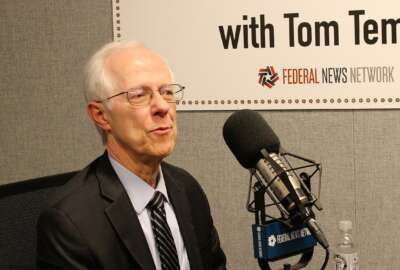Hubbard Radio Washington DC, LLC. All rights reserved. This website is not intended for users located within the European Economic Area.
Congress pressures agencies to speed up office consolidations
Members of the House Transportation and Infrastructure Subcommittee on Economic Development, Public Buildings and Emergency Management want to know why the NRC ...
wfedstaff | April 17, 2015 5:00 pm
The Nuclear Regulatory Commission is feeling the heat for moving too slowly to consolidate more than 1.2 million square feet of office space.
Members of the House Transportation and Infrastructure Subcommittee on Economic Development, Public Buildings and Emergency Management want to know why the NRC spent millions of dollars to renovate office space that it may never use.
“The American taxpayer is paying rent to house 1,800 empty workstations. By almost any measure, the NRC has far more office space than it needs and millions of dollars of taxpayers’ money are being wasted,” said Rep. Lou Barletta (R-Pa.), the chairman of the subcommittee. “In addition, about 1,600 of those workstations are located in a building where the lease expires at the end of the year. Yet despite the empty space and clear directives by the President, the NRC wants the committee to authorize a sole source renewal of this lease at the cost of $177 million.”
Barletta said the NRC utilization rate went from 195 usable square feet per person in 2007 to 322 square feet today. He said the utilization rate, or the amount of office space per employee, should be closer to 200 square feet.
Barletta and ranking member Rep. Eleanor Holmes Norton (D-D.C.) repeatedly tried to figure out why the NRC has so much extra office space and what it is doing to get rid of it.
William Borchardt, the executive director for operations at the NRC, told lawmakers the agency began leasing extra space in 2007 when it expected a huge increase in its workload of applications to build new nuclear power plants. But that increase never materialized and the NRC was left with unused office space.
Borchardt said the agency is taking steps to reduce its real estate holdings, starting with three satellite offices leased in Rockville, Md.
“Right now, we have already vacated one of those facilities. We have just transferred staff from a second facility into the new office space,” Borchardt said. “But we agree that the NRC doesn’t need, based upon our current best estimate of the workload and the staffing requirements, all of the office space for all three of the buildings in the White Flint campus. Our suggestion, and our best plan, is for us to retain White Flint 1 and White Flint 2 in its entirety …”
He said the goal is to get the usable space per employee down to 128 square feet from more than 300 currently.
The NRC is working with the General Services Administration and the Office of Management and Budget on a plan to further reduce office space as required under the White House’s Freeze the Footprint Initiative introduced in March.
Borchardt said if the NRC can’t terminate its current leases, it hopes to offer the extra space to another federal agency to help offset the government’s risk.
Dual roles for GSA
The NRC isn’t alone in the challenges it faces in trying to meet the White House and congressional mandates to consolidate office space.
GSA, which acts as the government’s landlord for about 375 million square feet of office space, is caught between the roles of enforcer and order taker because it has no legal or policy authority to force agencies to do anything.
For example, GSA and the Coast Guard are trying to terminate a lease for office space when the service moves into the St. Elizabeth’s headquarters later this year.
Dorothy Robyn, the commissioner of the Public Building Service at GSA, tried to explain to Barletta the challenge of consolidating office space.
“We were getting ready to use our one-time termination rights. That means we walk away from the lease,” she said in explaining the government’s plans for one of the Coast Guard’s current buildings.
Barletta interrupted Robyn saying the committee believes the termination couldn’t happen for two years and it would cost the government another $50 million.
Robyn said that’s not her understanding of the termination clause.
“This letter clearly says that doing this will save or avoid that $60 million so I think we have a factual misunderstanding,” she said. “If we were left with a $60 million bill we would be backfilling that. That doesn’t make sense to me.”
Despite challenges like this one, Robyn said civilian agencies have reduced the amount of office space by 10 percent, down to 3.1 million square feet over the last few years.
The biggest impediment to reducing office space further is the need for upfront funding for moving expenses and to reconfigure existing space.
Robyn said GSA needs help from Congress to address this challenge.
“The President’s 2014 budget includes $100 million specifically for us to work with other agencies to reconfigure and renovate GSA-owned space in support of that kind of improved utilization,” she said. “We’re also requesting funding for a number of individual specific projects that are large repair and alteration projects that are designed to renovate buildings so as to allow federal agencies to consolidate their space needs and co-locate with other federal agencies, and to move out of costly leases and into federally-owned space.”
Robyn also reiterated the need for a civilian BRAC authority to help more quickly dispose of unused or underutilized federal property.
HHS, DHS finding success
While lawmakers hounded the NRC and GSA for answers and more progress, subcommittee members praised the departments of Homeland Security and Health and Human Services for consolidating office space.
DHS is reducing its number of offices from 50 in the Washington metro area to 15 anchor locations, including the St. Elizabeth’s complex.
Jeffery Orner, the chief readiness support officer at DHS, said a recent pilot in his office cut the space needed by 50 percent so each employee had about 100 square feet. He said the reduction is helping DHS avoid spending $1 million annually on office space.
Orner said the pilot highlights the steps needed to makes less office space work.
“It took a fair amount of planning and preparation. We had to move to an IT backbone where everybody has a cell phone and laptop,” he said. “Supervisors had to put in place new performance standards that were measuring outcomes so we could get to the point where we were managing outcomes as opposed to keeping track of who shows up every day.”
Orner added employees don’t have an assigned desk, but once a week have to reserve a desk or private cubicle to work in the office.
“It’s working out very well. The workforce is very pleased with it,” he said. “It’s a model I would recommend on a much broader basis.”
DHS recently submitted its Freeze the Footprint plan to OMB and has a goal over the next three years to reduce its average square feet of office space from about 200 to below 150 per employee.
HHS has had a policy in place since March 2011 requiring the average usable square feet per employee should be no more than 170 down from 215.
Ned Holland, the assistant secretary for administration at HHS, said the agency consolidated four bureaus into one building taking the utilization rate from 273 square feet per person to 182 square feet by increasing the number of employees in the building to 4,500 from 2,800.
Over the term of that lease, the department expects to save $215 million due to the consolidation.
Barletta said the government has a huge opportunity in the next few years to change the makeup of its office space and save billions.
“[H]uge numbers of GSA leases are expiring in the next three years, which creates an easy opportunity to shrink our footprint,” he said. “In the National Capital Region alone, there are 24 million square feet of leases expiring and most of them have terrible utilization rates.”
RELATED STORIES:
Agencies forced to freeze office space footprint
From islands to log cabins, agencies struggle to offload excess property
Data analytics improving CFOs’ lines of sight for program execution
Copyright © 2024 Federal News Network. All rights reserved. This website is not intended for users located within the European Economic Area.
Jason Miller
Jason Miller is executive editor of Federal News Network and directs news coverage on the people, policy and programs of the federal government.
Follow @jmillerWFED
Related Topics





